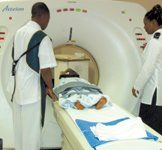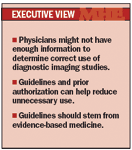One eye on the image and the other on the wallet
There is no question in anyone's mind that the increased use of high-tech diagnostic imaging has significantly improved the diagnosis and treatment of patients during the past decade.
There is no question in anyone's mind that the increased use of high-tech diagnostic imaging has significantly improved the diagnosis and treatment of patients during the past decade.

"These tools can reduce unnecessary or risky procedures," says Bruce Niebylski, MD, senior associate medical director for the Health Alliance Plan (HAP) in Detroit. "That's a wonderful thing."
Many physicians, especially those trained prior to 1990, lack the necessary skill sets to know when to order (and not to order) a high-tech diagnostic imaging service. As a result, physicians order these services when they are not appropriate, driving up the cost of healthcare.
"There are various estimates out there that say as many as one-third of the high-tech imaging services ordered are fairly discretionary, meaning they are nice to have, but they don't affect clinical management," says Keith Folkert, MD, medical director of health management for Minneapolis-based Blue Cross Blue Shield (BCBS) Minnesota.
Gregg P. Allen, MD, executive vice president and chief medical officer for MedSolutions, a Franklin, Tenn.-based company that provides radiology management products to health plans, says there is a "knowledge gap" among physicians about when to order what test at what point in a patient's workup. More training, he maintains, is needed.
FASTEST GROWING SEGMENT
This knowledge gap has produced an explosion in the amount that health plans pay for these services. For example, HAP, which has more than 500,000 members in Michigan and has 25 different networks of physicians, was paying $4 per-member per-month (2% of the healthcare premium) for radiology in 1999. Today, it is paying $15 per-member per-month (6% of the healthcare premium).

These cost increases are directly attributable to the growing utilization of high-tech imaging services.
"Earlier in [the] decade, pharmaceuticals was the leading area in which we were seeing tremendous cost growth," Weinstein says. "Imaging doesn't represent the highest proportion of every dollar of healthcare, but it is an area that represents one of the fastest-growing segments, especially in the outpatient side."
Recognizing that the costs of high-tech imaging services have to be brought under control, health plans have taken the lead by establishing clinical guidelines for their use-and making sure their providers know what those guidelines are. Some are teaming with radiology management companies to implement educational and prior authorization programs.
These programs are not being implemented solely to cut costs. Health plan executives say they are willing to spend the money on high-tech imaging, they just want to make sure that the money is being spent appropriately.
"We want to be sure that the right studies are being done for the right patients," Dr. Niebylski says. "We don't want redundant care or wrong care."
David Calabrese of OptumRx Talks New Role, Market Insulin Prices and Other Topics 'On His Mind'
April 13th 2023In this month’s episode of the "What's On Your Mind podcast," Peter Wehrwein, managing editor of MHE connects with the now Chief Clinical Officer of OptumRx Integrated Pharmacies, David Calabrese. In this conversation, David touches on his transition in January as OptumRx’s former chief pharmacy officer and market president of health plans and PBMs to his new role as Chief Clinical Officer where he now focuses more on things such as specialty pharmacy to home delivery — with an overall goal of creating whole-patient care. Throughout the conversation, Calabrese also touched on the market’s hot topic of insulin prices and behavioral health services within the OptumRx community, among other topics.
Listen
Upended: Can PBM Transparency Succeed?
March 6th 2024Simmering tensions in the pharmacy benefit management (PBM) industry have turned into fault lines. The PBMs challenging the "big three" have formed a trade association. Purchaser coalitions want change. The head of the industry's trade group says inherent marketplace friction has spilled over into political friction.
Read More
Briana Contreras, editor of Managed Healthcare Executive, spoke with Nancy Lurker, CEO and president of EyePoint Pharmaceuticals. Nancy shared a bit about EyePoint and how the organization’s innovative therapies are addressing patient needs through eye care, and most importantly, she addressed C-Suite positions like the CEO role. Nancy shared advice for those seeking to reach the CEO level, especially toward women in healthcare and other roles, and what it takes to run a biopharma company.
Listen
The deliberate disconnection of Change Healthcare to ring fence a cyberattack entered its seventh day today. Prescribers are finding ways to get pharmacy claims processed, and UnitedHealth Group says disruption to the dispensing of prescriptions has been minimal. But independent pharmacies want more information and protection from financial consequences from pharmacy benefit managers.
Read More